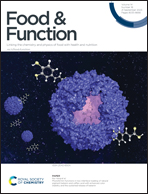Variations in physicochemical characteristics, antioxidant activity, phenolic and volatile profiles, and sensory attributes of tea-flavored Chardonnay wine during bottle aging†
Abstract
A novel Chardonnay wine flavored with either green tea or black tea was subjected to bottle aging for 9 months, and the physicochemical properties, antioxidant capacity, total phenolic content, volatile content and sensory properties were monitored. There were 272 phenolic and non-phenolic compounds characterized in the aged Chardonnay wines, including newly formed 9, 1, 3 and 8 phenolic compounds and 10, 6, 1 and 6 non-phenolic compounds after aging for 1, 3, 6 and 9 months, respectively. For all the aged wines, catechin was determined as the most abundant phenolic compound, and epigallocatechin mainly contributed toward the antioxidant power. A total of 54 volatile compounds were identified in the aged Chardonnay wines, including 17 odor-active compounds. The aging process diminished floral and fruity odors, but intensified green odor. The consumer study revealed the highest consumer liking for 1% (w/v) black tea infused wine. This study revealed the quality and bioactivity of this novel flavored wine type during aging which is critical to understand the shelf-life and functionality of the product.



 Please wait while we load your content...
Please wait while we load your content...